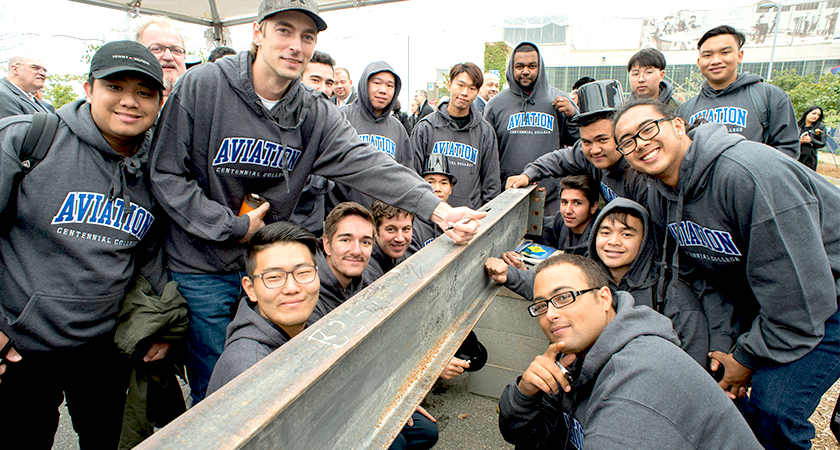Centennial College topped off its Bombardier Centre for Aerospace and Aviation under construction at Downsview Park on October 11. Students, staff, dignitaries, and guests were on hand to sign a steel I-beam before it was hoisted and incorporated into the new hangar that forms the central feature of the rejuvenated former headquarters of de Havilland Canada.
The $72-million project includes the hangar, which is large enough to accommodate today's commercial jets, as well as new classrooms, laboratory space, workshops, offices and a library. The campus is slated to open in the fall of 2018 and will have access to working runways for the first time.
Centennial currently trains about 300 aircraft and avionics technicians at its Ashtonbee Campus hangar in Scarborough. By comparison, the 138,000-square-foot Bombardier Centre for Aerospace and Aviation will have enough instruction space to accommodate 900 students annually.

The project, led by MJMA | Stantec (Architects in Association), involves repurposing the historic de Havilland building, located at 65 Carl Hall Road, with selective demolition and new construction. The Canadian government contributed $18.4 million in Strategic Investment Funds towards the new campus, and the Ontario government provided $25.8 million.
The project is seen as the first step towards creating an aerospace training and research hub for the development of new technologies in Ontario – an ambitious goal that was first outlined in the 2012 review of the Canadian aerospace industry by the Honourable David Emerson.
Centennial's newest campus will anchor the Downsview Aerospace Innovation and Research (DAIR) consortium, which is working to maintain Canada's ranking as a major aerospace supplier to the world. DAIR brings together the University of Toronto Institute for Aerospace Studies, Toronto Metropolitan University (formerly Ryerson University) and York University, as well as industry partners Bombardier, Safran Landing Systems, MDA, Canadensys, Pratt & Whitney Canada, FlightSafety, Honeywell and UTC Aerospace.
The historic de Havilland facility is renowned for having built the Mosquito, a light bomber that was one of the fastest aircraft of the Second World War, able to attain 425 miles per hour at 30,000 feet. It was one of the few front-line aircraft of the era constructed almost entirely of wood, primarily balsawood, spruce and Canadian birch. De Havilland Canada's 7,000 employees assembled 1,134 of the remarkable "Mossies" to help in the war effort.
